Kevin Feige On How 'Doctor Strange' Will Change The Marvel Universe [On Set Interview]
In February 2016, I traveled to London to get a glimpse at another dimension and visit the set of Marvel's Doctor Strange. While on set we got a chance to have a long chat with Marvel Studios head Kevin Feige, who as always, provided us with a lot of hints at what to expect from the future of the Marvel Cinematic Universe.
Feige talks about Doctor Strange's origin story, how the movie will be different from the comics, rooting crazy concepts in real science, does Steven Strange know about The Avengers, how the film is more respectful to other cultures than the original source material may have been, how this movie was inspired by The Oath, which characters might connect with the Runaways, Mads Mikkelsen's character Kaecilius, multiple dimensions, the trouble with writing magic action, how Mordo is different in the movie, Rachel McAdams' character Christine Palmer, is the eye of agamotto an infinity stone, the genre of the film, how this film will defy expectations, Steven Strange's role in the larger MCU, will we see cameos from the other Marvel characters, and much more.
If you're a Marvel fan and have ever read a Kevin Feige interview before then, you know this is well worth your time. Hit the jump to open the portal.
Please note: Some of this interview has been edited down, and the order of the questions have been altered slightly, for your enjoyment.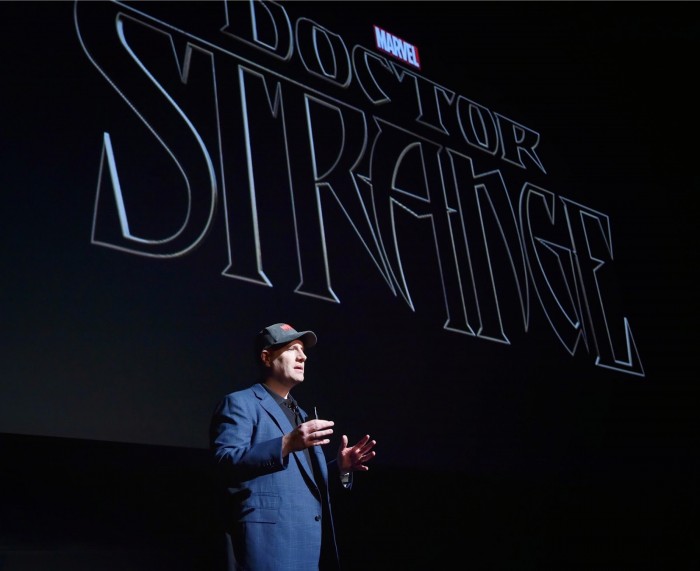
Kevin Feige Doctor Strange Interview
Doctor Strange is an interesting character because he's been in the Marvel Universe for a very long time, but he's had a lot of different iterations. He's come and gone. He's had different series. Some of the characters have had very specific throughlines, but there's been a lot of different versions and different takes on Doctor Strange. Where are you guys pulling from in that long and varied history to find your Doctor Strange?Kevin Feige: Yes, his origin has always been, like Tony Stark's, relatively stable, relatively consistent, and we're certainly pulling from that – the arrogant New York neurosurgeon, who's a bit of an ass, who's extremely arrogant, and who has a horrible accident, mangles his hands – his tools – and who loses his identity and loses himself. He has a nice downward spiral, before finding his way in a last-ditch effort in something he doesn't really believe into Nepal, to the people who he will encounter and who will teach him and open his eyes to a whole other reality.
So we're certainly doing that origin. I think it's one of the coolest origins in our comics. From a cinematic point of view, it's certainly the most interesting singular character journey maybe since Iron Man 1 that we've plucked from the books.
And I would say that Steve Ditko and the art of Steve Ditko is a huge inspiration for us. Not really anything in this room, but for a lot of our interpretation of the multiverse and various dimensions come right out of all of the art of those early comics that Mr. Ditko did, and challenging our amazing visual effects vendors and visual effect supervisors – saying, 'Let's put this on the screen.'
It's really weird. You don't want to turn away from that. You suddenly don't want to make it sort of... turn it into a galactic cosmos... it needs to be strange. It needs to be weird. It needs to be absolutely inspired from those images. I'm sure Scott Derrickson will talk to you today, and I think it might even be his twitter handle picture – a particularly panel from the Ditko era that I think was turned into a blacklight poster that he remembered having. And that is been so much of the visual inspiration of the movie.
And then I think you look at his interaction with other characters in the books. You know, I think The Oath tonally was a great, not reinterpretation, but a great updating of his character. And I think we would've probably leaned in that direction anyway, because that sort of fits what we like to do in our films and certainly that's what Benedict is bringing to it – a sense of humor to go along with the gravitas that this journey he goes on. I think those are many of our touch-points for the movie.
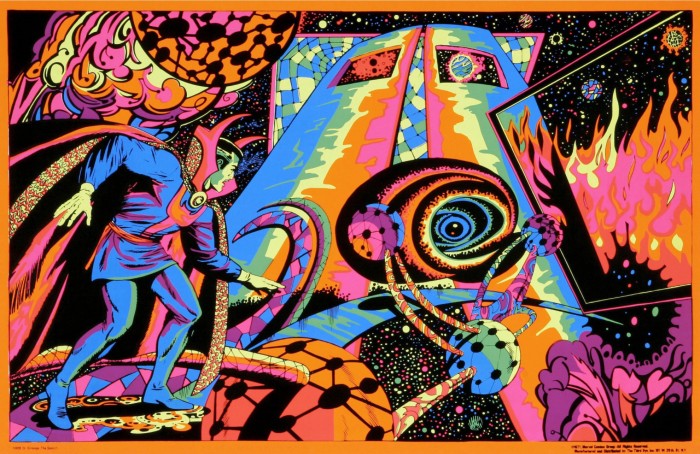 The idea of magic was introduced and written-off in a single line in Thor. What made you want to bring magic back into the Marvel universe in a full proper way like this now?Kevin Feige: I don't know if it was written off in that single line in Thor. It was given another way of looking at it. There are a couple of lines in Thor basically saying that science and magic, it gets to a point where what's the difference. And I think we're continuing that. The Ancient One encounters Strange – he's a scientist, he's learned Western Medicine; he believes very much in that. She starts using Eastern lingo in the way she's describing the world to him. He immediately writes it off – he rolls his eyes, he doesn't buy it, and she goes okay, and she starts talking about it in Western terms to try and make him more comfortable. She says it's the same thing. Whether you're looking at the ancient study of acupuncture pressure points or you're looking an MRI – she's trying to say we're talking about the same things here. And if you're not comfortable with the word spells, let's use the word program. It's all the same thing. And I think that's true to a certain extent – I think for the audience and the way science is going. I'm not a scientist. I just read articles that are interesting and that capture my imagination, but I think there's a reason why there's so much faith placed in science.
The idea of magic was introduced and written-off in a single line in Thor. What made you want to bring magic back into the Marvel universe in a full proper way like this now?Kevin Feige: I don't know if it was written off in that single line in Thor. It was given another way of looking at it. There are a couple of lines in Thor basically saying that science and magic, it gets to a point where what's the difference. And I think we're continuing that. The Ancient One encounters Strange – he's a scientist, he's learned Western Medicine; he believes very much in that. She starts using Eastern lingo in the way she's describing the world to him. He immediately writes it off – he rolls his eyes, he doesn't buy it, and she goes okay, and she starts talking about it in Western terms to try and make him more comfortable. She says it's the same thing. Whether you're looking at the ancient study of acupuncture pressure points or you're looking an MRI – she's trying to say we're talking about the same things here. And if you're not comfortable with the word spells, let's use the word program. It's all the same thing. And I think that's true to a certain extent – I think for the audience and the way science is going. I'm not a scientist. I just read articles that are interesting and that capture my imagination, but I think there's a reason why there's so much faith placed in science.
For a long time there was a prologue in this movie that we're not doing – maybe we'll do in part two, so maybe I shouldn't mention it – but it took place in CERN. If you think about CERN, it comes up a lot in SF story because it's so mind-blowing what's actually being done there, and we've looked at that a lot because of the discussions about parallel dimensions and multiple-dimensions, and all of that has gone into building the foundation for our fictional reality within the Strange universe. And then you go back and look at the comics and look at the journey the Ancient One takes Strange on in the comics, and it's all the same thing. They didn't know about parallel dimensions back then – they were making it up or tapping into philosophies for it, and now I think it's more relevant and potentially, theoretically, more realistic than ever. Realistic being a relative term here.
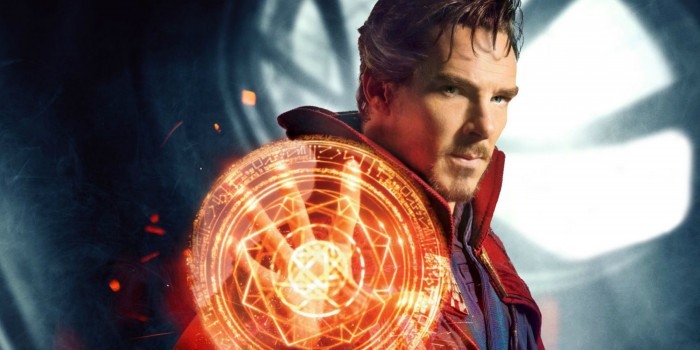 How hard is it to set the rules of science and magic?Kevin Feige: It's very hard because you don't want to rule yourself out into it being mundane, or rule yourself into not being fantastical or magical. And certainly, we're not doing that. And you've heard me talk about the quantum realm in Ant-Man which was certainly designed for that movie and for that story to take the notion of somebody who has the ability to shrink to another level we've never seen before, but as we were doing that, and studying it and talking to the science advisors who are always more than willing to spend an afternoon with us and talk about these amazing things – the quantum realm is another dimension. It tapped into what we had been working on with this movie as well, so that really became the notion that we're scratching the surface of the quantum realm and then we just do a deep dive in this.
How hard is it to set the rules of science and magic?Kevin Feige: It's very hard because you don't want to rule yourself out into it being mundane, or rule yourself into not being fantastical or magical. And certainly, we're not doing that. And you've heard me talk about the quantum realm in Ant-Man which was certainly designed for that movie and for that story to take the notion of somebody who has the ability to shrink to another level we've never seen before, but as we were doing that, and studying it and talking to the science advisors who are always more than willing to spend an afternoon with us and talk about these amazing things – the quantum realm is another dimension. It tapped into what we had been working on with this movie as well, so that really became the notion that we're scratching the surface of the quantum realm and then we just do a deep dive in this.
A lot of it is – is it cool? Is it entertaining? Does it give us visuals we've never seen before? That's been particularly hard on this film to find outside of the comic books, and the Ditko art work, comparables for the visuals we want to bring to this. Our visual effects supervisor has amazing reference and all of it is sort of close to what we want but none of it exactly what we want, which is an exciting place to be in because the visuals you will ultimately see in November we might not have seen yet because they're still being designed and being developed.
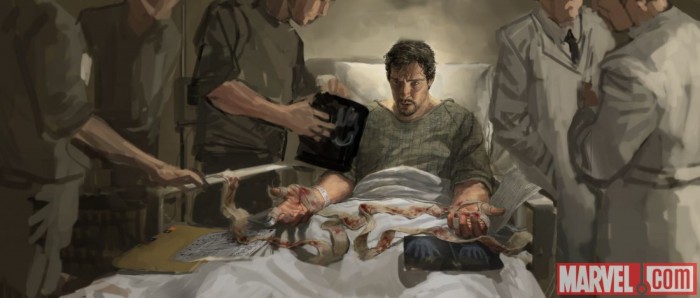 We're at a point now in the MCU where you've pretty much set up everybody. Origins stories are few and far between. What have you guys learned that you're applying here?Kevin Feige: Well, it's an origin story in this film in particular, because it's always been our model – with a few exceptions – to introduce a character, introduce their world, and then have the fun of me being that character in another movie down the line. Iron Man, Cap, Thor, most recently Ant-Man, and that's certainly what we're doing in Strange.
We're at a point now in the MCU where you've pretty much set up everybody. Origins stories are few and far between. What have you guys learned that you're applying here?Kevin Feige: Well, it's an origin story in this film in particular, because it's always been our model – with a few exceptions – to introduce a character, introduce their world, and then have the fun of me being that character in another movie down the line. Iron Man, Cap, Thor, most recently Ant-Man, and that's certainly what we're doing in Strange.
If you didn't know this movie was connected to 13 movies before it, nothing in this movie would indicate that was the case. This is very much a standalone introduction to a very complex character and a very complex world, which through this movie and until maybe some upcoming movies is relatively self-contained. There are people inhabiting the same world that are stopping buildings from falling down, robots from doing this, aliens from doing that – these people in this movie are stopping inter-dimensional forces from wiping out all of reality.
So although it doesn't necessarily come up, we've always assumed that the sorcerers have bigger fish to fry when they hear there's something in a city or there's a bank being robbed. They're not thinking about it. They're thinking if we don't keep vigilant our sense of reality will disappear, and there won't be a bank to rob and there won't be a city to be conquered.
How well known is he to get the shout-out in Winter Soldier?Kevin Feige: He's very well known as a surgeon. He's got various awards and plaques. He attends various galas. Might be driving to one at one point in this movie. So he has name recognition, and a talent and certain Hydra computers identified him as someone who could cause trouble for their agendas.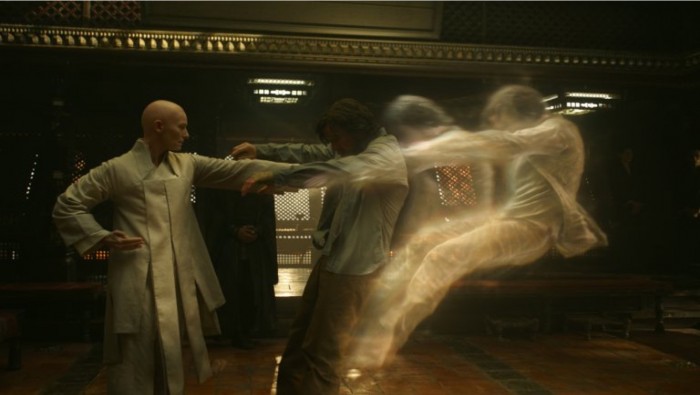 When Doctor Strange was first introduced, we met him in the '60s it was a very different world, a very different culture. A lot of the stuff that was introduced in there that would seem stereotypical today. In the 21st century, when you're approaching some of this Eastern stuff, how do update it in a way so that you're hitting the fun pulp stuff while still being respectful to other cultures in a way Stan Lee and Steve Ditko weren't really worried about.Kevin Feige: This is very much the Marvel version of this story. These sorcerers aren't inspired by any actual sect or any actual religion. They're from the Marvel bullpen, and we're being respectful of that, and we're using that fictional mythology to bring to life our fictional world.
When Doctor Strange was first introduced, we met him in the '60s it was a very different world, a very different culture. A lot of the stuff that was introduced in there that would seem stereotypical today. In the 21st century, when you're approaching some of this Eastern stuff, how do update it in a way so that you're hitting the fun pulp stuff while still being respectful to other cultures in a way Stan Lee and Steve Ditko weren't really worried about.Kevin Feige: This is very much the Marvel version of this story. These sorcerers aren't inspired by any actual sect or any actual religion. They're from the Marvel bullpen, and we're being respectful of that, and we're using that fictional mythology to bring to life our fictional world.
But being authentic in the way you'll see today on the sets that Charles Wood has designed for us, being authentic in filming, as we did for the first week on production on this in Nepal and in Kathmandu. It was important to us to make it feel like these were real locations and real things. Costumes certainly are designed to evoke the superhero comic elements, with some touches of other various cultures. But we're really trying to be true to the fictional mythology that was created in the past.
When you get into individual characters, certainly there's been things that have been updated – most obviously Tilda Swinton taking on the role of the Ancient One. We talked about the Ancient One being a title that has been held probably for hundreds and hundreds of years by individuals, but there've been various ones, and the one we meet in this movie happens to be a female of Celtic descent, who most people, even those who surround her, have forgotten exactly where she came from because she's been around. I think we state in the movie hundreds and hundreds of years – they're not sure exactly how long. So that was one way of doing a new interpretation of that character.
Benedict Wong is a very different incarnation of that character. He's an amazing actor who has done an amazing job bringing this role to life. He is not the assistant manservant. He was loyal in the books, and certainly fulfilled a purpose which I think could be one of the things you're describing – a stereotype going back to any number of white hero-Asian driver, servant. That is not his role in this movie at all. Everyone in this movie knows more in Strange. Everyone is more talented when it comes – for 90% of the movie, the magical abilities and the mastery of the mystic arts than Strange is, and Wong is a fellow warrior who has been a master in his own right. As we meet him in this movie, he's tasked with protecting some of the most valuable relics and book Kamar-Taj has. He doesn't have a lot of time to worry about Strange. So those are a few of the ways we've updated those characters.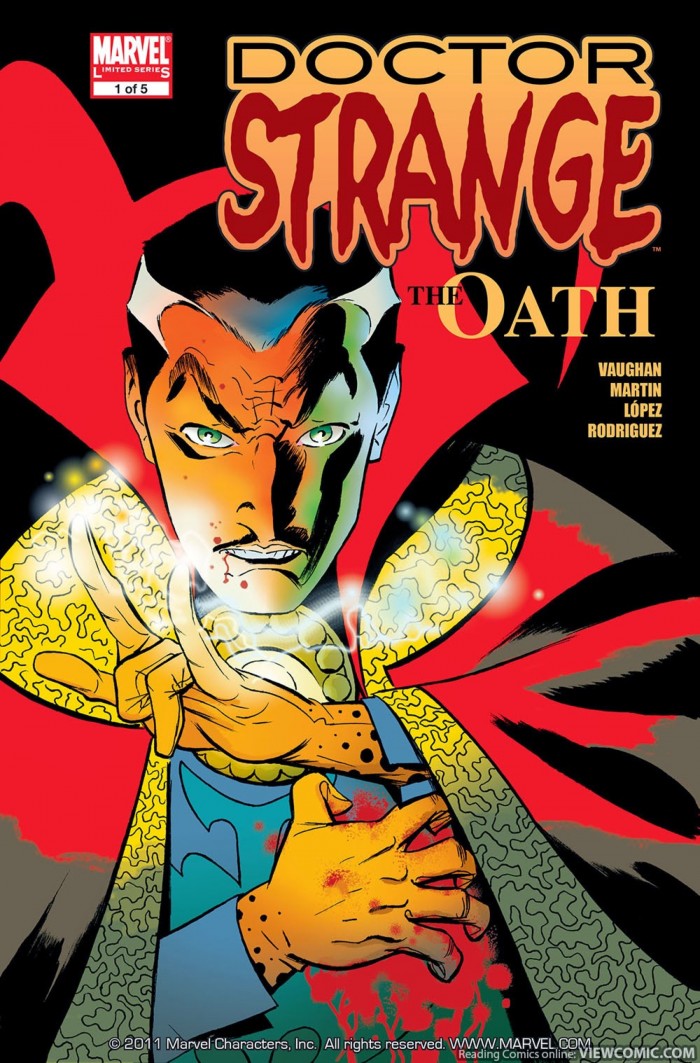 You mention The Oath as an inspiration. Is this an adaptation of that comic run?Kevin Feige: When we mention the Oath, it's more tonally. That had a very fun tone to it. Doctor Strange had a unique, fun voice. Even his voice in this movie, I don't think you'd initially go – oh I remember that in the Oath, but actually there's a sequence from the Oath which directly inspired a sequence in this movie, which was a sequence that Scott actually included in his very earliest pitches to us. Maybe there was a character or two whose name we took from that, but this is not an adaptation of that story.
You mention The Oath as an inspiration. Is this an adaptation of that comic run?Kevin Feige: When we mention the Oath, it's more tonally. That had a very fun tone to it. Doctor Strange had a unique, fun voice. Even his voice in this movie, I don't think you'd initially go – oh I remember that in the Oath, but actually there's a sequence from the Oath which directly inspired a sequence in this movie, which was a sequence that Scott actually included in his very earliest pitches to us. Maybe there was a character or two whose name we took from that, but this is not an adaptation of that story.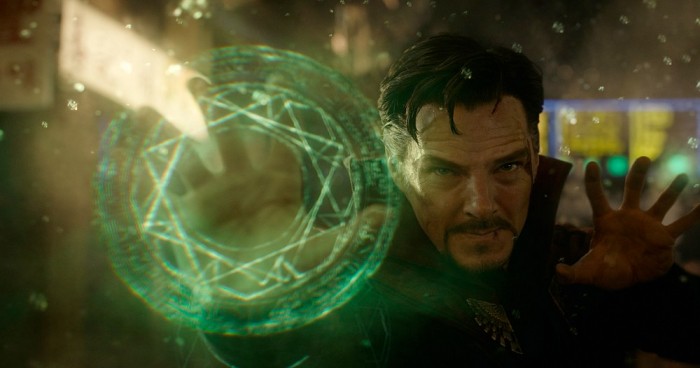 Do you find that as audiences become more accustomed to superhero stories that you need to change things?Kevin Feige: Yeah, I think the more movies we make, the deeper we go into the comic books. The more we're able to bring to life aspects of the comics that haven't been brought to life before. The benefit of that is we get to make movies that feel different to movies we've made before.
Do you find that as audiences become more accustomed to superhero stories that you need to change things?Kevin Feige: Yeah, I think the more movies we make, the deeper we go into the comic books. The more we're able to bring to life aspects of the comics that haven't been brought to life before. The benefit of that is we get to make movies that feel different to movies we've made before.
I don't know that a movie like Doctor Strange couldn't have been the second or third film we made. I don't think we're doing anything in that requires past viewing, as opposed to Civil War which we wouldn't have done as the first or second movie because so much of that film is based on the pre-existing relationships between the characters. So the more films we make, the more we get to deal with those pre-existing relationships. But when it comes to a movie like Ant-Man or Guardians or certainly Doctor Strange, it's just bringing to life stuff that's already been there in the comics, and we finally get a chance to do it on the big screen.
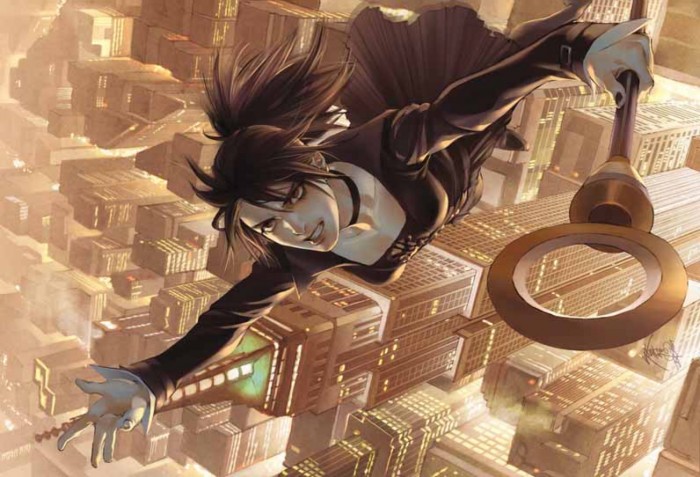 There's a couple of characters names over here that are pretty exciting for comic book fans with Drum and Minoru. How much of that is just nodding to the comics versus just setting things up for the future? Because obviously Runaways has been a topic of conversation for quite a few years now, and seeing that name is pretty exciting.Kevin Feige: Of Drum and Minoru that you mention, one of those names you hear in the movie, and one of those – I don't think... We never say Minoru in the movie, do we? No. So that picture, if it is in the art of book, is the only place you'd ever see that name.
There's a couple of characters names over here that are pretty exciting for comic book fans with Drum and Minoru. How much of that is just nodding to the comics versus just setting things up for the future? Because obviously Runaways has been a topic of conversation for quite a few years now, and seeing that name is pretty exciting.Kevin Feige: Of Drum and Minoru that you mention, one of those names you hear in the movie, and one of those – I don't think... We never say Minoru in the movie, do we? No. So that picture, if it is in the art of book, is the only place you'd ever see that name.
Drum, you do hear the name in the movie. That's how we always build the universe. There's so many characters in the books that if we have need for a person to be in this place at this time and have a line or have no lines, we still want it to be someone, and oftentimes that's how the names come about. And the names we pull are the ones that are relatively top of mind or have been amongst characters we've thought about, like the Runaways for a long time. I would call that an Easter Egg that most people won't even see.
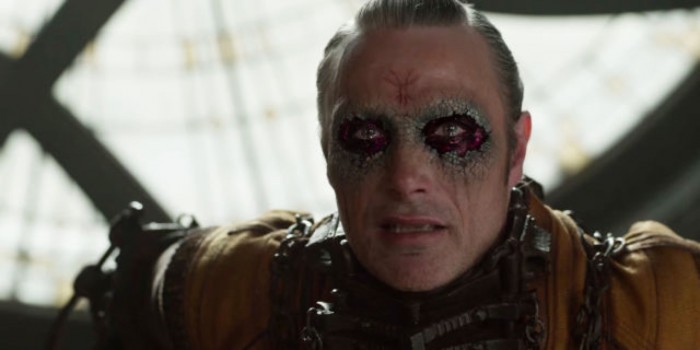 Who's the antagonist?Kevin Feige: The Antagonist is Mads Mikkelsen, who plays a character called Kaecilius. He was a sorcerer within Kamar-Taj, who along with some other of his followers, who are called zealots, defect from Kamar-Taj because they believe the Ancient One is not being truthful in the way that she is teaching sorcery. They believe she is withholding secrets that should not be withheld, and think that maybe it's not a bad thing if other dimensions absorb our reality. In fact, that could lead to benefits such as immortality. They may also lead to destroying the entire world as we know it. But it is definitely a philosophical break that he has from the rest of the sorcerers that is his primary angst over the course of the movie.There's a tendency towards these doppelganger villains with superhero stories in general? What's the plus of that? Is it just a logistical thing where we just want to show as much magic as possible clashing against magic? Do you have thoughts and ideas of showing, down the line, a magical hero against a technological villain?Kevin Feige: Certainly we'll get to that. I think in the case of any – you want to have characters that inhabit the same world when introducing a new world, a new mythology for lack of a better term. You want to explore that as much as you can. Kaecilius doesn't know Strange from a hole in the wall. He predates him. But when you're teaching an audience about sorcerers and that reality and you're going to talk about the past anyway and you're going to get into their history anyway, much better to tie-in your bad guy with that instead of laying all this groundwork of parallel dimensions and sorcery and say, by the way, a meteor hit on the other side of the world, it went under the water, and this evil thing developed. What does that have to do with magic? Nothing, but we've got to stop it. That's not the way we've developed them up to this point. Needless to say as more characters encounter each other in other films they're certainly going to be up against things that they don't know anything about and have no comparable to.
Who's the antagonist?Kevin Feige: The Antagonist is Mads Mikkelsen, who plays a character called Kaecilius. He was a sorcerer within Kamar-Taj, who along with some other of his followers, who are called zealots, defect from Kamar-Taj because they believe the Ancient One is not being truthful in the way that she is teaching sorcery. They believe she is withholding secrets that should not be withheld, and think that maybe it's not a bad thing if other dimensions absorb our reality. In fact, that could lead to benefits such as immortality. They may also lead to destroying the entire world as we know it. But it is definitely a philosophical break that he has from the rest of the sorcerers that is his primary angst over the course of the movie.There's a tendency towards these doppelganger villains with superhero stories in general? What's the plus of that? Is it just a logistical thing where we just want to show as much magic as possible clashing against magic? Do you have thoughts and ideas of showing, down the line, a magical hero against a technological villain?Kevin Feige: Certainly we'll get to that. I think in the case of any – you want to have characters that inhabit the same world when introducing a new world, a new mythology for lack of a better term. You want to explore that as much as you can. Kaecilius doesn't know Strange from a hole in the wall. He predates him. But when you're teaching an audience about sorcerers and that reality and you're going to talk about the past anyway and you're going to get into their history anyway, much better to tie-in your bad guy with that instead of laying all this groundwork of parallel dimensions and sorcery and say, by the way, a meteor hit on the other side of the world, it went under the water, and this evil thing developed. What does that have to do with magic? Nothing, but we've got to stop it. That's not the way we've developed them up to this point. Needless to say as more characters encounter each other in other films they're certainly going to be up against things that they don't know anything about and have no comparable to.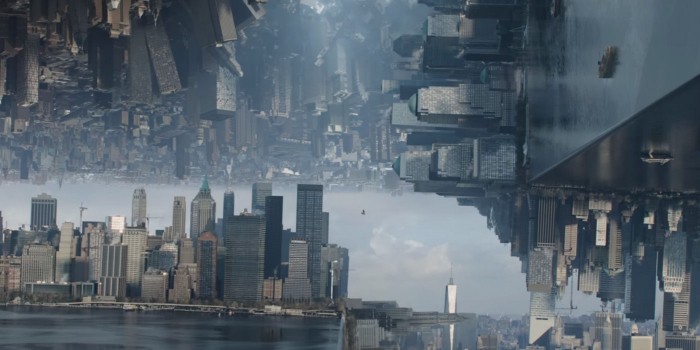 How deep into the world of alternate dimensions and parallel dimensions do you go?Kevin Feige: Real deep.Is there a scenario where we see a different version of earth?Kevin Feige: I think when comic book fans hear parallel dimensions or multiple dimensions they think of Earth 616 and Earth 617 and Earth 618. That's all possible. But what we're playing with in this world is there are dimensions – that the other dimensions are not just parallel realities, although some of them are, but there are the Dark Dimension where Dormammu inhabits; there are dimensions that are so mind-bending that you can barely perceive them; there are dimensions where a lot of the Ditko images come from; there are dimensions that are just mind trips that the human mind can barely fathom which is why it's hard to turn them into something to show audiences in November. But we're playing as much with the notion of the multiverse as much as alien dimensions, for lack of a better term, than parallel realities where there's Strange that wears Iron Man armor – we're not there yet.
How deep into the world of alternate dimensions and parallel dimensions do you go?Kevin Feige: Real deep.Is there a scenario where we see a different version of earth?Kevin Feige: I think when comic book fans hear parallel dimensions or multiple dimensions they think of Earth 616 and Earth 617 and Earth 618. That's all possible. But what we're playing with in this world is there are dimensions – that the other dimensions are not just parallel realities, although some of them are, but there are the Dark Dimension where Dormammu inhabits; there are dimensions that are so mind-bending that you can barely perceive them; there are dimensions where a lot of the Ditko images come from; there are dimensions that are just mind trips that the human mind can barely fathom which is why it's hard to turn them into something to show audiences in November. But we're playing as much with the notion of the multiverse as much as alien dimensions, for lack of a better term, than parallel realities where there's Strange that wears Iron Man armor – we're not there yet.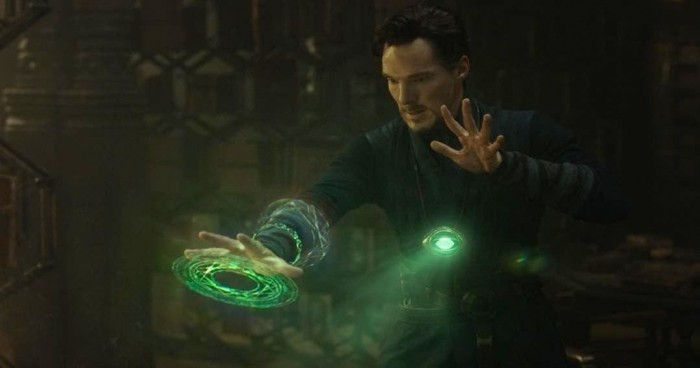 What was the toughest nut to crack on this?Kevin Feige: I would say the use of magic for action sequences was something that took a long time to figure out what road to take. Scott was very smart in not wanting it to simply be: someone shoots a bolt of lightning, and someone blocks a ball of lightning, so someone throws another bolt of lightning, so someone blocks another bolt of lightning.
What was the toughest nut to crack on this?Kevin Feige: I would say the use of magic for action sequences was something that took a long time to figure out what road to take. Scott was very smart in not wanting it to simply be: someone shoots a bolt of lightning, and someone blocks a ball of lightning, so someone throws another bolt of lightning, so someone blocks another bolt of lightning.
There are interpretations of that. But we wanted to do something different, and we wanted to tap into this notion of the multiverse, of dimensions right next to our own. And if you were able to tap into those dimensions, and those other powers, and what could you do if you pulled aspects of those other dimensions into our realm. All in the interest of creating a visual tapestry that is totally different in terms of an action scene we've seen in any other movies.
We've seen light blast versus light blast before. Again, there's some of that in this movie for impact, and for dynamic attacks, but the four main action scenes have been structured around which power from which dimensions are they going to be used to screw with our world now. And in doing so, giving a canvas for an action scene totally different than anything we've ever done before. So something that starts as a foot chase becomes totally unrecognizable. Something that starts as we've got to stop the clicking clock before it goes off is completely turned on its head. And that was something that was challenging for years and years leading up to this movie, and when Scott started and when our first writer – Jon Spaihts – we really focussed on and crack and build the rest of the movie around.
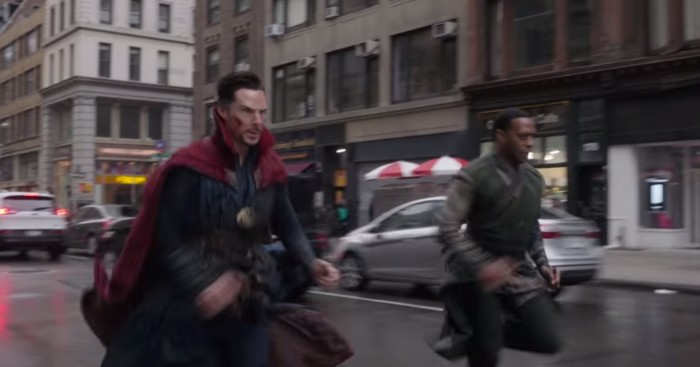 Can you speak a little about the relationship between Strange and Mordo, because traditionally they've had something of a fractious, murdery dynamic?Feige: He is different in this movie. Portrayed by Chiwetel Ejiofor, he is Strange's advocate in the beginning of the movie. The Ancient One doesn't necessarily see the potential in Strange that Morodo does, and Morodo is the one who talks the Ancient One into allowing him in. And for this film, he is a partner of Strange, and he is a mentor to Strange. You know that was something we wanted to play against in the comics. Because in the comics for as unbelievably creative and full of imagination as they are – we are desperate to recreate in cinematic form – there's some things that are too obvious for modern day audiences. The jealous rival named Baron von Mordo, who turns against him when he shows any signs of talent – we specifically didn't want to do that.
Can you speak a little about the relationship between Strange and Mordo, because traditionally they've had something of a fractious, murdery dynamic?Feige: He is different in this movie. Portrayed by Chiwetel Ejiofor, he is Strange's advocate in the beginning of the movie. The Ancient One doesn't necessarily see the potential in Strange that Morodo does, and Morodo is the one who talks the Ancient One into allowing him in. And for this film, he is a partner of Strange, and he is a mentor to Strange. You know that was something we wanted to play against in the comics. Because in the comics for as unbelievably creative and full of imagination as they are – we are desperate to recreate in cinematic form – there's some things that are too obvious for modern day audiences. The jealous rival named Baron von Mordo, who turns against him when he shows any signs of talent – we specifically didn't want to do that.
It's one of the reasons we cast Chiwe because we wanted to have someone who had sort of unbelievable authenticity in delivering a lot of wackadoo lines and exposition. The other day on set there was a line, which is a spoiler so I won't say it, but it involved a tongue twister of various names and incantations, and I said to Steven, who was on set, 'Steven, maybe we can simplify this for Chiwetel. That's a mouthful. I can barely say it". Steven talks to Chiwetel. Chiwetel goes, 'I got it. Don't worry about me. I'm fine.' Sure enough, he says, and you go 'why was I even worried. Why did I even question that line could be said?' He kills it. So he is very much an ally in this film.
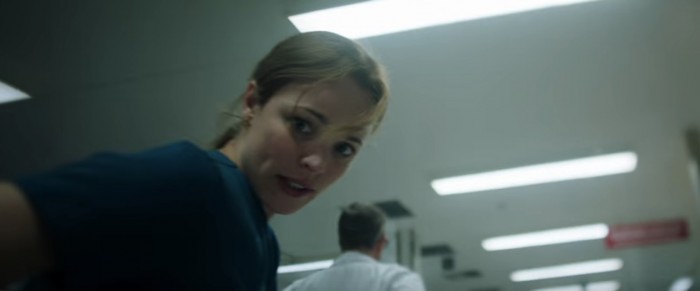 When Rachel McAdams was first involved and announced, there was this sort of assumption that if you're having a female lead in a Doctor Strange movie that it would be Clea. You've gone with a much more grounded character. Can you talk about the decision to leave that character for a future adventure?Kevin Feige: We wanted a grounded character. We wanted a character that was a connection to Strange's life in New York City, in the normal world. Somebody that could be his anchor to the real world, to his present in the beginning of the film, and by the time he re-encounters her, wearing that, someone who can comment on his transformation as a character. This cast as you all know is shockingly amazing, and Rachel, who's finished 99% of her role – perfect timing so she can spend time at the Academy Awards now, we planned it like that – is great and can bring again a grounded reality to the character of Strange at the beginning of the film and of course as she encounters some odd and strange and other-worldly when he, encounters her late in the movie, you believe it. You believe that her reaction to what she is seeing like, say, an astral form or somebody that she used to know as an arrogant surgeon. Her reaction is funny but you also buy it.At the end of Ant-Man, one of the end scenes, Hope van Dyne sees the Wasp suit, and says 'about damn time' which I think a lot of fans felt the same way. What's going to make this character different from the litany of superhero girlfriends that have come before? There were super-powered girlfriends for Doctor Strange, but you're going with the human. What makes her different?Kevin Feige: The super-powered girlfriend for Strange wasn't in the first issue. There's a lot of backstory required for her, which is one of the reason we didn't go that way. There's so much to set up in this. I think it's always a huge mistake when you throw the kitchen sink and everything in the first movie. I don't think it's a mistake to put every great idea into the first movie, because I've always said there won't be a second movie if you go 'we'll hold back these ideas for another one. Oh no, you've ruined the first one'. So we put in all the great ideas that can be brought into the film in the service of introducing the world to an audience who's never heard of it and doesn't know it from a hole in the wall. And we thought that an inter-dimensional girlfriend that's the daughter of an inter-dimensional demon-esque creature was a step too far in introducing this world.
When Rachel McAdams was first involved and announced, there was this sort of assumption that if you're having a female lead in a Doctor Strange movie that it would be Clea. You've gone with a much more grounded character. Can you talk about the decision to leave that character for a future adventure?Kevin Feige: We wanted a grounded character. We wanted a character that was a connection to Strange's life in New York City, in the normal world. Somebody that could be his anchor to the real world, to his present in the beginning of the film, and by the time he re-encounters her, wearing that, someone who can comment on his transformation as a character. This cast as you all know is shockingly amazing, and Rachel, who's finished 99% of her role – perfect timing so she can spend time at the Academy Awards now, we planned it like that – is great and can bring again a grounded reality to the character of Strange at the beginning of the film and of course as she encounters some odd and strange and other-worldly when he, encounters her late in the movie, you believe it. You believe that her reaction to what she is seeing like, say, an astral form or somebody that she used to know as an arrogant surgeon. Her reaction is funny but you also buy it.At the end of Ant-Man, one of the end scenes, Hope van Dyne sees the Wasp suit, and says 'about damn time' which I think a lot of fans felt the same way. What's going to make this character different from the litany of superhero girlfriends that have come before? There were super-powered girlfriends for Doctor Strange, but you're going with the human. What makes her different?Kevin Feige: The super-powered girlfriend for Strange wasn't in the first issue. There's a lot of backstory required for her, which is one of the reason we didn't go that way. There's so much to set up in this. I think it's always a huge mistake when you throw the kitchen sink and everything in the first movie. I don't think it's a mistake to put every great idea into the first movie, because I've always said there won't be a second movie if you go 'we'll hold back these ideas for another one. Oh no, you've ruined the first one'. So we put in all the great ideas that can be brought into the film in the service of introducing the world to an audience who's never heard of it and doesn't know it from a hole in the wall. And we thought that an inter-dimensional girlfriend that's the daughter of an inter-dimensional demon-esque creature was a step too far in introducing this world.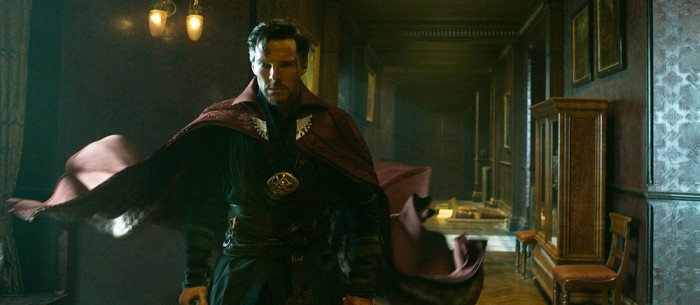 I'm really interested in how Stephen Strange changes. Not just becoming a magic user but from that arrogant neurosurgeon. Does his arrogance alter as he goes through this journey or is he still arrogant but with immense magical powers?Kevin Feige: We've talked about that in comparison to Tony Stark, who is an arrogant, witty fellow at the beginning of the movie who sells weapons and then as an arrogant, witty fellow at the end of the movie who doesn't sell weapons, who channels his wit and his intelligence into something else but is kind of the same guy. Strange's transformation is much complete than that. He really does begin to recognize the way he was acting earlier and the reasons he was acting like that earlier are things that he identifies and attempts to correct over the course of the movie. So he is, he is very much a different guy at the end of the film at the beginning, not just because he wears a cool outfit instead of scrubs.
I'm really interested in how Stephen Strange changes. Not just becoming a magic user but from that arrogant neurosurgeon. Does his arrogance alter as he goes through this journey or is he still arrogant but with immense magical powers?Kevin Feige: We've talked about that in comparison to Tony Stark, who is an arrogant, witty fellow at the beginning of the movie who sells weapons and then as an arrogant, witty fellow at the end of the movie who doesn't sell weapons, who channels his wit and his intelligence into something else but is kind of the same guy. Strange's transformation is much complete than that. He really does begin to recognize the way he was acting earlier and the reasons he was acting like that earlier are things that he identifies and attempts to correct over the course of the movie. So he is, he is very much a different guy at the end of the film at the beginning, not just because he wears a cool outfit instead of scrubs.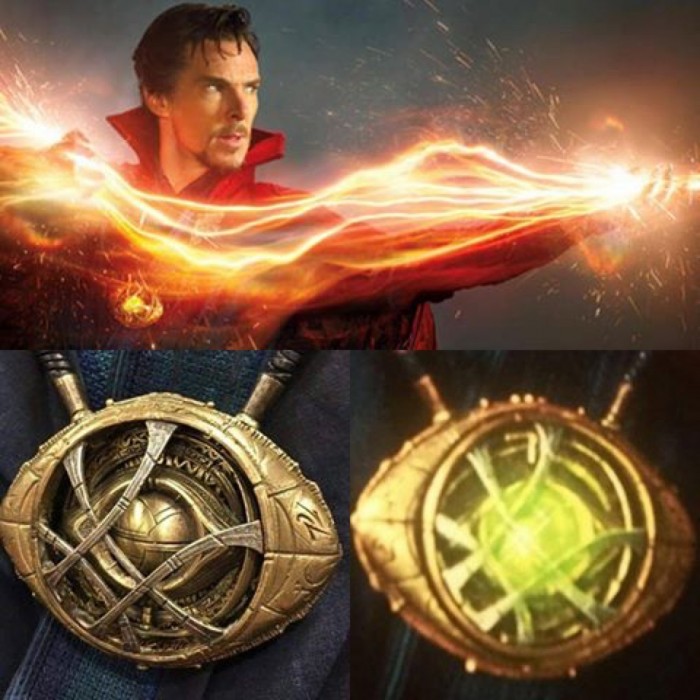 There are a few Infinity Stones we haven't seen yet. Might one of them be important to this movie?Kevin Feige: If you're tracking such things, perhaps. But we don't get into it in this movie because, again, we've got...- Shall we look at an eye of Agamotto?Kevin Feige: It's closed. You can look at it as long as you want. But again, there's a lot to take in in this movie, there are a lot of new concepts, there are a lot of new characters, there's a lot of new mythologies that we didn't to clutter up by telling you about other MacGuffins.In terms of this film's role in Phase 3 or the greater MCU, is this film's role because it's the first Doctor Strange movie is to introduce magic and the character or does it need to lay groundwork for Infinity War?Kevin Feige: All the above. All the above. Most obviously it'll introduce a new character who will be in play in the universe, but once you have gotten an audience to buy into a new concept then it's fun to keep, to play-off, or spin-off that concept down the line.
There are a few Infinity Stones we haven't seen yet. Might one of them be important to this movie?Kevin Feige: If you're tracking such things, perhaps. But we don't get into it in this movie because, again, we've got...- Shall we look at an eye of Agamotto?Kevin Feige: It's closed. You can look at it as long as you want. But again, there's a lot to take in in this movie, there are a lot of new concepts, there are a lot of new characters, there's a lot of new mythologies that we didn't to clutter up by telling you about other MacGuffins.In terms of this film's role in Phase 3 or the greater MCU, is this film's role because it's the first Doctor Strange movie is to introduce magic and the character or does it need to lay groundwork for Infinity War?Kevin Feige: All the above. All the above. Most obviously it'll introduce a new character who will be in play in the universe, but once you have gotten an audience to buy into a new concept then it's fun to keep, to play-off, or spin-off that concept down the line.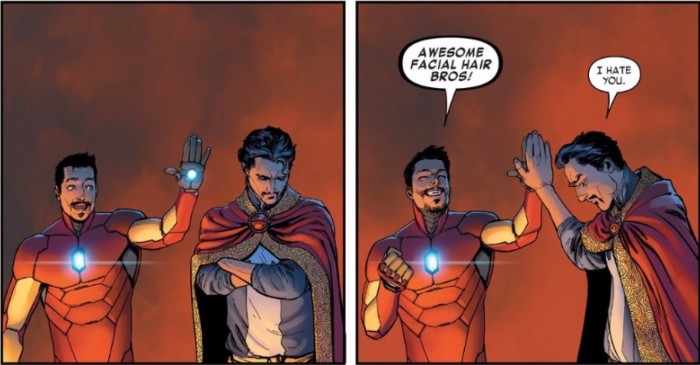 How aware is Strange of what is happening in the MCU currently?Kevin Feige: It doesn't come up much in this film. One would imagine that anyone living in New York was aware of what had occurred in various instances. But like in our real life, people go about their daily business, their job, and his job is to be the best neurosurgeon and to take the best cases and to get the most attention and to get the most accolades and that's what he's focussed on until his accident. So he doesn't spend a lot of time talking or thinking about The Avengers.What is Strange's role in the MCU? In the comics, he's always been something of a fringe character, who pops in when he's needed. In the MCU, we've really enjoyed just watching these characters hangout. Is Strange going to be the kind of character who would pop up in an end-credits sequence listening to Tony Stark babble or is he character that's only going to be involved when things are bad?Kevin Feige: I don't think he does a lot of hanging out, necessarily. No, he usually gets involved when – as I said, he's not going to intervene in the bodega crime down the street. But as things get bigger and as threats get bigger he can serve a very good purpose and can make his presence known.Is Spider-Man going to swing by the Sanctum Sanctorum for advice about something in school? Is he going to be that involved in the MCU? Or is he only going to pop in again in Infinity War?Kevin Feige: Time will tell. Time will tell.
How aware is Strange of what is happening in the MCU currently?Kevin Feige: It doesn't come up much in this film. One would imagine that anyone living in New York was aware of what had occurred in various instances. But like in our real life, people go about their daily business, their job, and his job is to be the best neurosurgeon and to take the best cases and to get the most attention and to get the most accolades and that's what he's focussed on until his accident. So he doesn't spend a lot of time talking or thinking about The Avengers.What is Strange's role in the MCU? In the comics, he's always been something of a fringe character, who pops in when he's needed. In the MCU, we've really enjoyed just watching these characters hangout. Is Strange going to be the kind of character who would pop up in an end-credits sequence listening to Tony Stark babble or is he character that's only going to be involved when things are bad?Kevin Feige: I don't think he does a lot of hanging out, necessarily. No, he usually gets involved when – as I said, he's not going to intervene in the bodega crime down the street. But as things get bigger and as threats get bigger he can serve a very good purpose and can make his presence known.Is Spider-Man going to swing by the Sanctum Sanctorum for advice about something in school? Is he going to be that involved in the MCU? Or is he only going to pop in again in Infinity War?Kevin Feige: Time will tell. Time will tell.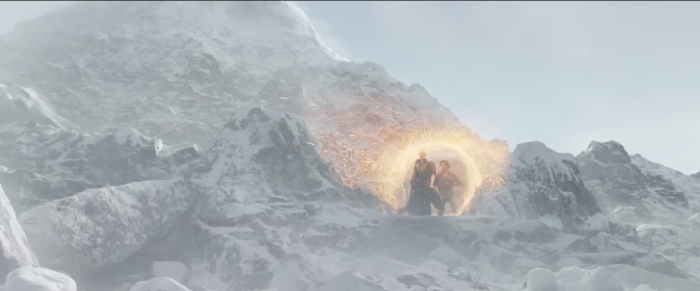 What genre is this?Kevin Feige: Well, you should ask Scott, I think it does tap into a supernatural type of genre that is not horror. People say 'Scott's movies are kind of scary, is this a horror movie?' Of course, it's not a horror movie. But what Scott has done so well in the best of his films is have one foot completely in the real world and one foot in this whatever supernatural subgenre he was playing with. I do think we've looked at this film not with any direct genre comparison but as a play on the supernatural genre. Certainly more so than we've done in the past, which is what makes his journey from person that doesn't wear a cape to person who does wear a cape – cloak, much more unique than we've seen in the past.
What genre is this?Kevin Feige: Well, you should ask Scott, I think it does tap into a supernatural type of genre that is not horror. People say 'Scott's movies are kind of scary, is this a horror movie?' Of course, it's not a horror movie. But what Scott has done so well in the best of his films is have one foot completely in the real world and one foot in this whatever supernatural subgenre he was playing with. I do think we've looked at this film not with any direct genre comparison but as a play on the supernatural genre. Certainly more so than we've done in the past, which is what makes his journey from person that doesn't wear a cape to person who does wear a cape – cloak, much more unique than we've seen in the past.
Also, you should also talk to Alex. Alex has designed, I think, more red capes than anyone else. I swear, and you can look at it, you can look at the inside of that too. It's always my fear that you put a red cape on somebody and – I thought people would think Thor was Superman for the longest time. She designed the original Thor cape. The red cape that goes over the shoulder of Thor, the folds on the back. This cloak – the asymmetry to it, the design, the specificity of it – is astounding. When you are designing something that is quite extreme in the comics and you see that collar is not shy around his neck there, you want to do justice to it but you also want it – there's a reason these characters feel unique in the comics as well – you want to bring that to life. She's done that in an amazing way. The cloak, unlike Thor's cape or Superman's cape or Vision's cape, as you may recall from the comics, I wouldn't say has sentience, but is not just a piece of fabric. It helps Strange out in ways that other character's clothing has not.
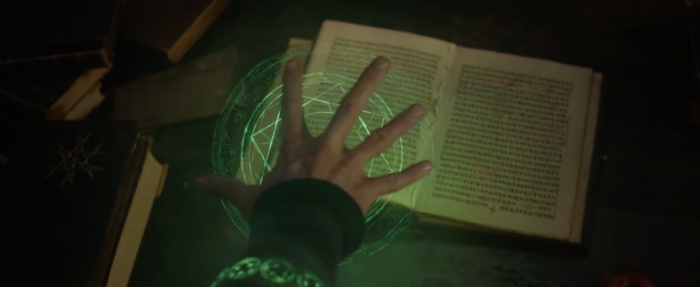 Will this movie defy expectations? That's something you guys always have to do now. For example, Ant-Man, we're going to do the finale in a bedroom. And maybe not specific to the ending, how does this movie – aside from obviously the supernatural and the magic – maybe in more of a straight story way?Kevin Feige: Well, without spoiling things, it's hard to say. I do think that as I said before the canvas of action sequences and the way in which the sequences unfurl will be very unique and will be different than any movie we've made before, and that's what makes it interesting, what makes it special, and what makes it worth pursuing, and worth bringing to life for the first time. We do not want to repeat ourselves or do what's been done before necessarily, and when you have a track record now you can either do that and keep, this seems to work and let's keep doing this – which some people accuse us of no matter what, because I don't think they pay attention, but really what we do is say, 'Okay, we have a studio that trusts us and let's us do what we want for the most part with the creative. We have audiences that seem to be embracing whether they've heard of the characters or not. Let's use that to make as interesting and different and unique a story as possible and not just stay with the same thing.' And this movie is certainly the embodiment of that.
Will this movie defy expectations? That's something you guys always have to do now. For example, Ant-Man, we're going to do the finale in a bedroom. And maybe not specific to the ending, how does this movie – aside from obviously the supernatural and the magic – maybe in more of a straight story way?Kevin Feige: Well, without spoiling things, it's hard to say. I do think that as I said before the canvas of action sequences and the way in which the sequences unfurl will be very unique and will be different than any movie we've made before, and that's what makes it interesting, what makes it special, and what makes it worth pursuing, and worth bringing to life for the first time. We do not want to repeat ourselves or do what's been done before necessarily, and when you have a track record now you can either do that and keep, this seems to work and let's keep doing this – which some people accuse us of no matter what, because I don't think they pay attention, but really what we do is say, 'Okay, we have a studio that trusts us and let's us do what we want for the most part with the creative. We have audiences that seem to be embracing whether they've heard of the characters or not. Let's use that to make as interesting and different and unique a story as possible and not just stay with the same thing.' And this movie is certainly the embodiment of that.
